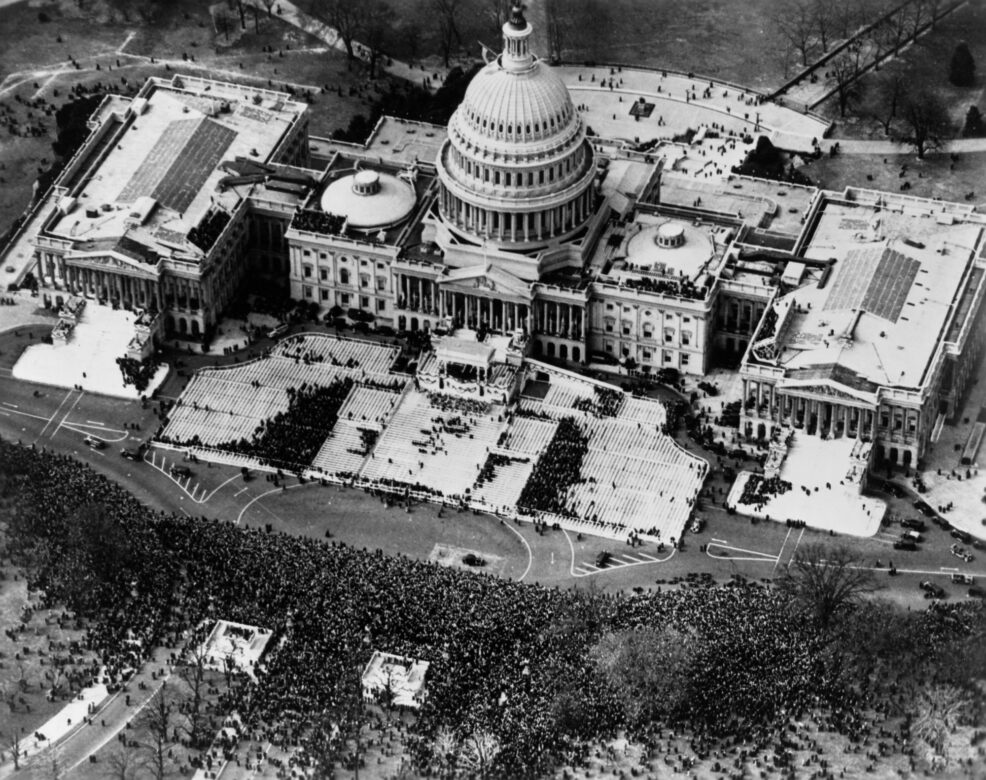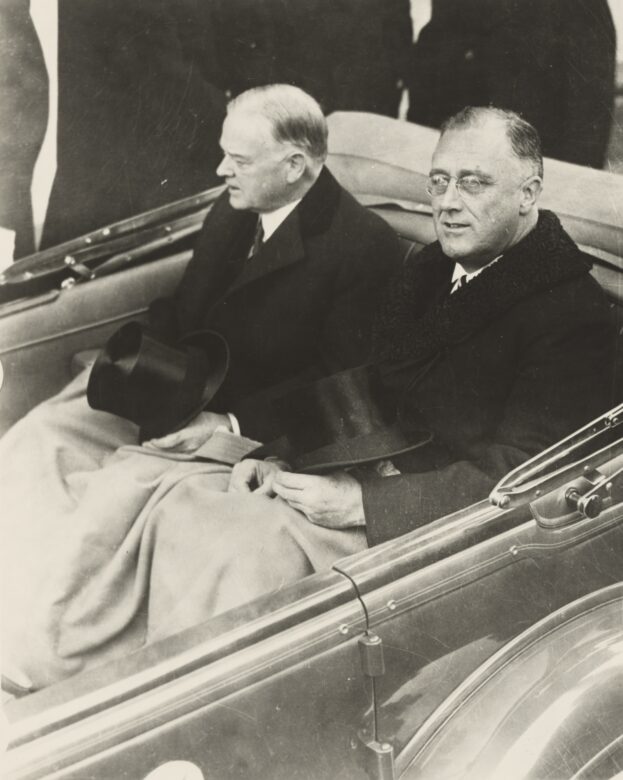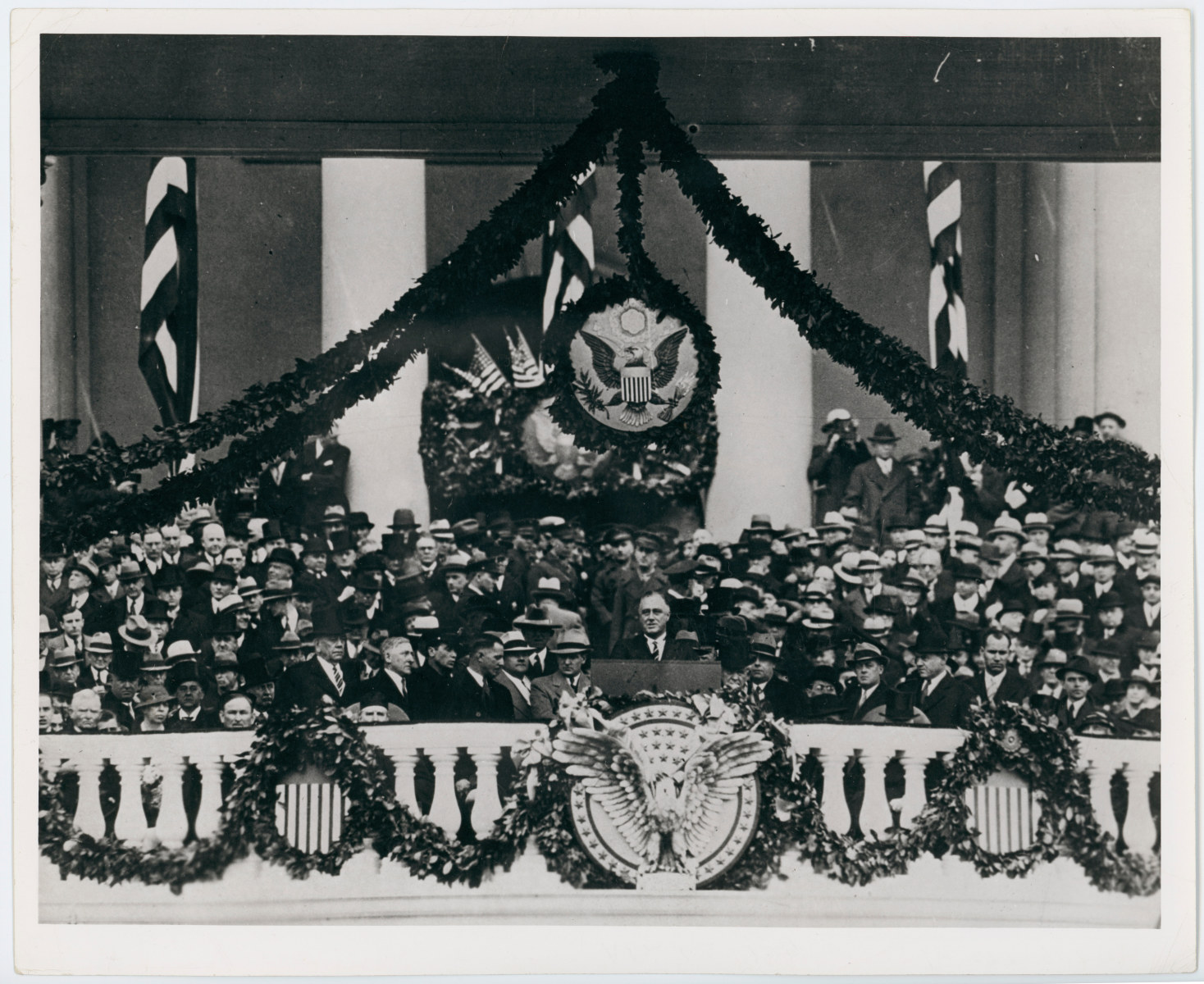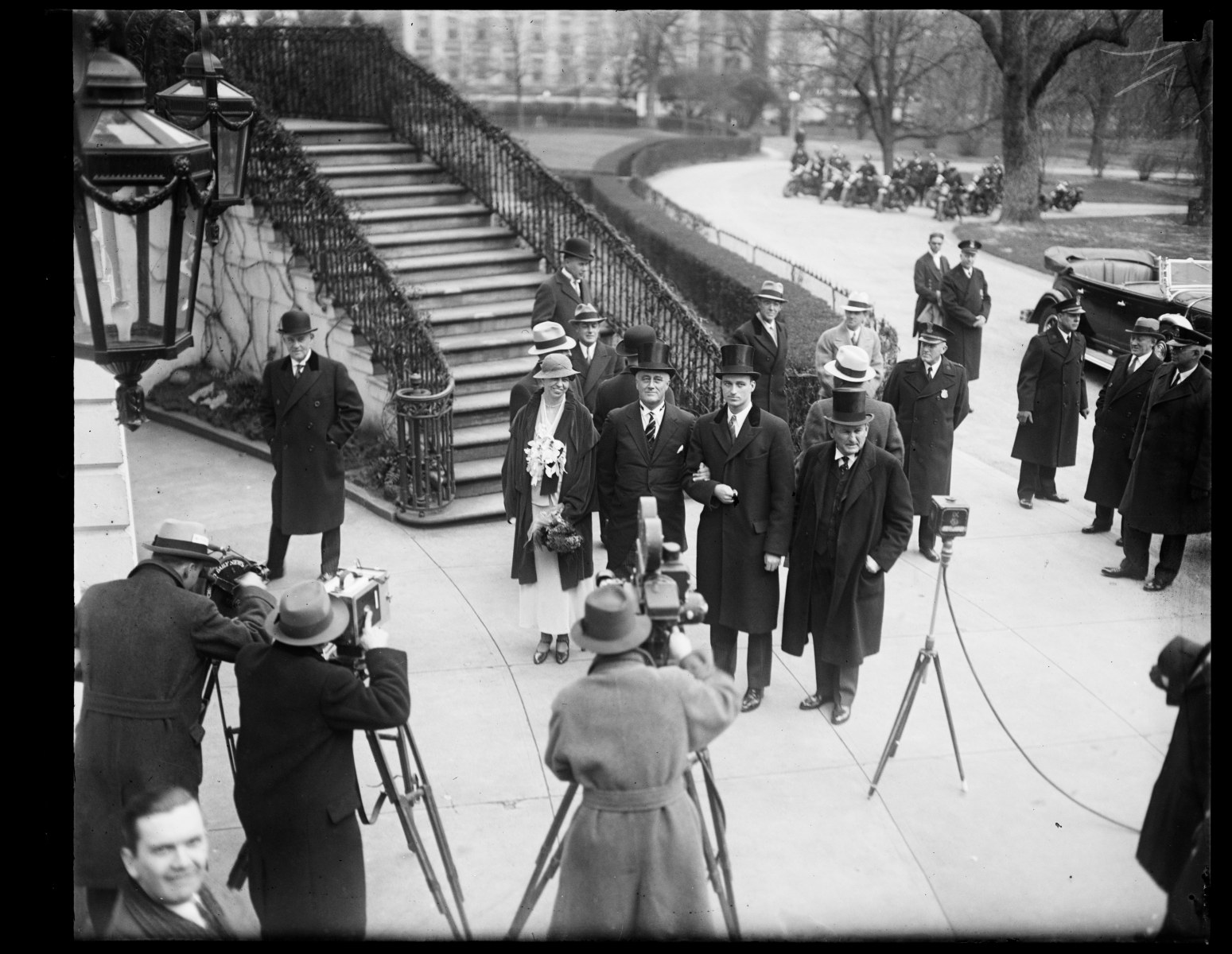Collection The Presidents
Biographies & Portraits
Main Content
March 4, 1933
How Long? 7 minutes

An estimated 150,000 spectators gather on the East Front of the U.S. Capitol on March 4, 1933, in this unique aerial view.
Library of CongressFranklin Delano Roosevelt won his first presidential campaign with messages of optimism and hope. At the Chicago Democratic Convention in June of the previous year, “Happy Days are Here Again” had become the campaign song, inspiring voters to support a candidate who promised a way out of the country’s worsening economic depression.1Roosevelt had won the election handily, but by March 1933, a national mood of uncertainty had returned. A banking crisis forced banks in dozens of states to close their doors, and despite President Herbert Hoover’s strenuous efforts to shore up the economy there seemed no end in sight. The president-elect had given little indication of how he would tackle the crisis, and Americans wondered what he would do. The inauguration would provide an early glimpse of what they could expect in the coming four years.
The skies over Washington, D.C., were initially sunny but quickly grew overcast as Roosevelt arose early on March 4 and prepared for the day’s momentous activities. Portents were gloomy, as all flags in the capital had been lowered to half-staff in memory of Montana Senator Thomas J. Walsh who had died two days before. At 10 a.m., the president-elect and his entourage, which included family, staff and cabinet members and their families, assembled at St. John’s Episcopal Church for a short prayer service. Reverend Endicott Peabody, Roosevelt’s former schoolmaster, presided over worship. Afterwards, the president-elect returned to his hotel before emerging again for the short trip to the White House’s North Entrance. Roosevelt waited in his car as President Hoover joined him. Eleanor Roosevelt and First Lady Lou Hoover sat in the car behind as both vehicles, tops down, joined the procession to the Capitol.
It was not a comfortable ride. The outgoing president and the president-elect—the former exhausted and the latter no doubt mulling the challenges before him—shared a blanket to ward off the cold, but found little to say to each other. Newsreel cameras recorded their departure and two-mile trip down Pennsylvania Avenue, capturing the tension between the two presidents.

President-elect Franklin D. Roosevelt and outgoing President Herbert Hoover on the ride from the White House to the Capitol for the inauguration on March 4, 1933.
Library of CongressAt the Capitol, Hoover—businesslike to the end—entered the President’s Room to sign a few final documents while Roosevelt prepared to take the oath of office. Hoover’s vice president and president of the Senate, Charles Curtis, swore in the new vice president, John Nance Garner, in the Senate chamber. The dramatis personae and their guests then made their way to the inaugural stand on the Capitol’s east front. The president-elect, partially paralyzed from polio, proceeded to the podium grasping the arm of his son James as the Marine Band performed “Hail to the Chief.” Waiting for him there was Chief Justice Charles Evans Hughes, perched above a crowd estimated at 150,000 people. Fortuitously, somebody remembered the flags lowered to half-staff, and those above the Capitol were raised to full staff, symbolically befitting the occasion.2
The atmosphere was redolent of “high tension and anxiety” as the ceremonies began. Chief Justice Hughes read the oath, which the new president repeated word for word as his hand rested on a Dutch family Bible opened to 1 Corinthians 13:13: “And now abideth faith, hope and charity, these three; but the greatest of these is charity.” As a twenty-one gun salute boomed, President Roosevelt shook hands with Hughes and then turned to face the people. His speech, delivered in a strong voice for several minutes, echoed his campaign theme of hope with the memorable sentences: “This great Nation will endure as it has endured, will revive and will prosper. So, first of all, let me assert my firm belief that the only thing we have to fear is fear itself—nameless, unreasoning, unjustified terror which paralyzes needed efforts to convert retreat into advance.”3

President Franklin D. Roosevelt delivers his first inaugural address, telling those gathered that “the only thing we have to fear is fear itself.”
Franklin D. Roosevelt Presidential Library and Museum/NARAAfter bidding Hoover and his family farewell, President Franklin Roosevelt and First Lady Eleanor Roosevelt returned to their open car for the trip back to the White House. The route was lined by what reporters called “two solid lines of humanity” who “shouted themselves hoarse” as the president smiled and waved his top hat, and the First Lady “acknowledged the plaudits with a graceful nod and a smile.” After a buffet luncheon at the White House, the new First Family reviewed the inaugural parade from a stand fashioned after Andrew Jackson’s Hermitage. Led by Chief of Staff Douglas MacArthur and the Army Band, the parade was a massive affair that lasted nearly four hours, with a “stream of bands, military units, marching clubs, floats, drum corps and automobiles.”4
Even then the festivities had not nearly ended. At dusk the president returned to the White House, where a “tea” with 2,000 guests was underway. Roosevelt departed this event early, going upstairs to the Second Floor Oval Room where he met with his Cabinet. Congress, in a spirit of unity and recognition of the crisis gripping the country, had confirmed the entire Cabinet immediately and without debate. The president served as master of ceremonies as Justice Benjamin Cardozo administered oaths, and then congratulated his new deputies.5
President Roosevelt desired to convey an aura of physical strength in an era when disabilities were often stigmatized, avoiding displays of or reference to his own disability during the inauguration ceremonies. The Institute for Rehabilitation that he had founded at Warm Springs, Georgia in 1927 was however never far from his mind. After the oaths were administered, Roosevelt returned downstairs to welcome a group of thirteen disabled children who had been convalescing at Warm Springs. Afterwards he joined First Lady Eleanor Roosevelt and several dozen guests for a formal dinner convened at eight o’clock in the State Dining Room.

President Franklin D. Roosevelt and First Lady Eleanor Roosevelt pose for cameras at the bottom of the South Portico of the White House after his inauguration at the Capitol on March 4, 1933.
Library of CongressAfter a full and trying day and with numerous challenges ahead, the president relaxed with his secretary before turning in early. City residents and thousands of visitors were in no hurry to end the day, however. Clubs and organizations that had participated in the inaugural parade engaged in public competitions along Constitution Avenue, while a fireworks display on the grounds of the Washington Monument attracted thousands of revelers.
While her husband slept, First Lady Eleanor Roosevelt ushered several cars full of VIP guests to the Washington Auditorium, where the inaugural promenade, concert and ball began at ten o’clock. Mrs. Roosevelt was dressed in a sleeveless blue lame gown that the press dubbed “Eleanor Blue,” along with a diamond necklace and orchid corsage. The large crowd of wealthy guests who paid $150 per ticket (all for charity) cheered her lustily as she entered the hall to the band’s performance of a fanfare and march. Camera bulbs popped incessantly until she held up a finger and laughingly told the reporters to cease and desist. After presentations of various dignitaries and performances of tunes such as the “Star-Spangled Banner,” the first lady returned to the White House to rejoin her husband.7
As Inauguration Day ended, the Great Depression remained just as real as it had been that morning. The real work had not even begun. If for only a moment, however, the menace of national crisis had receded just a little. The day had been wrought with symbolism—and orchestrated to that very purpose. Journalists—who had never warmed to the outgoing president—hailed Roosevelt’s inauguration as restoring hope to the country. The events had been broadcast live via radio to millions of Americans, and blanket newspaper and newsreel coverage ensured that the inauguration’s visual and visceral impact would continue for months to come. Whether they agreed with the new president’s program or not, no one could deny that the country was on a new course.
Biographies & Portraits
Throughout our history, presidents have faced crises that have gripped both the nation and the world. In this episode, Association...
The White House Historical Association and the Eleanor Roosevelt Papers Project present this collaboration in an effort to open a...
In April 1789, George Washington took the oath of office in New York City. Constitutional guidelines for inaugurations are sparse, offering...
President Franklin D. Roosevelt was elected to office at the height of the Great Depression. He ushered in an environment...
Every year since 1981, the White House Historical Association has had the privilege of designing the Official White House Christmas Ornament....
Whether by hoof, air, waterway, road, or rail, the President’s access to reliable transportation is essential during their time in...
Camp David has provided presidents and their families with a recreational retreat from the White House, as well as a...
President Harry S. Truman was close to his friends and associates, had a grin for strangers, but could be less...
The White House Historical Association (WHHA) offers many different resources for students working on National History Day projects.
The White House Historical Association will convene in Washington, D.C. for the 2023 Presidential Sites Summit. The theme “Change and Co...
NUMBERS 1 THROUGH 6 (COLLECTION I) WHITE HOUSE HISTORY • NUMBER 1 1 — Foreword by Melvin M. Payne 5 — President Kennedy’s Rose Garden by Rachel Lambert...